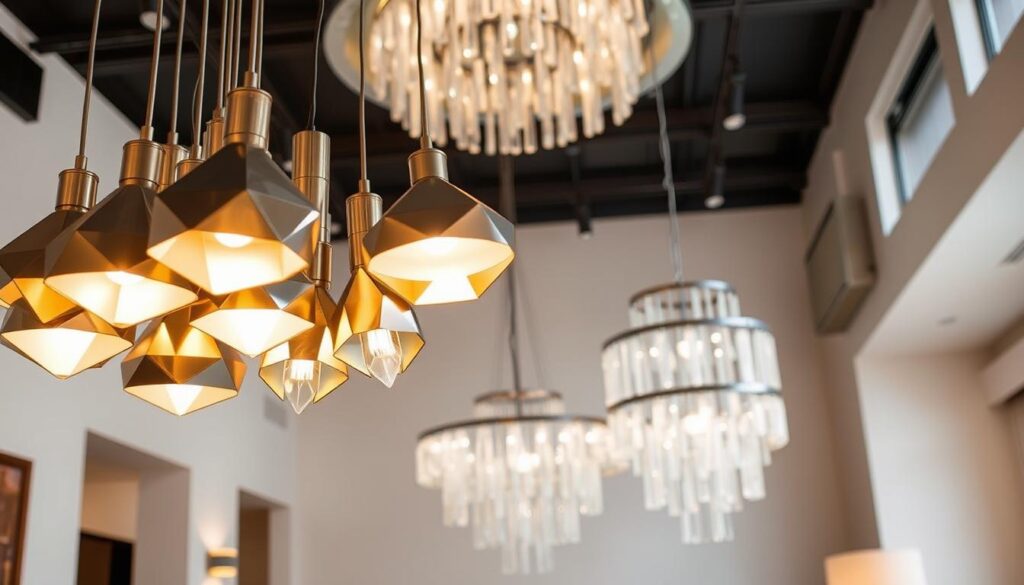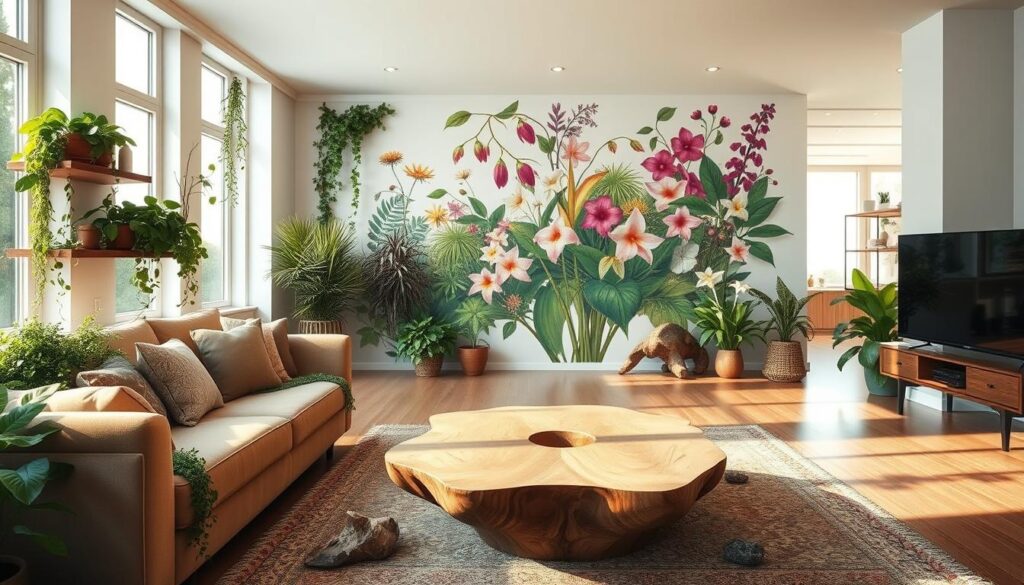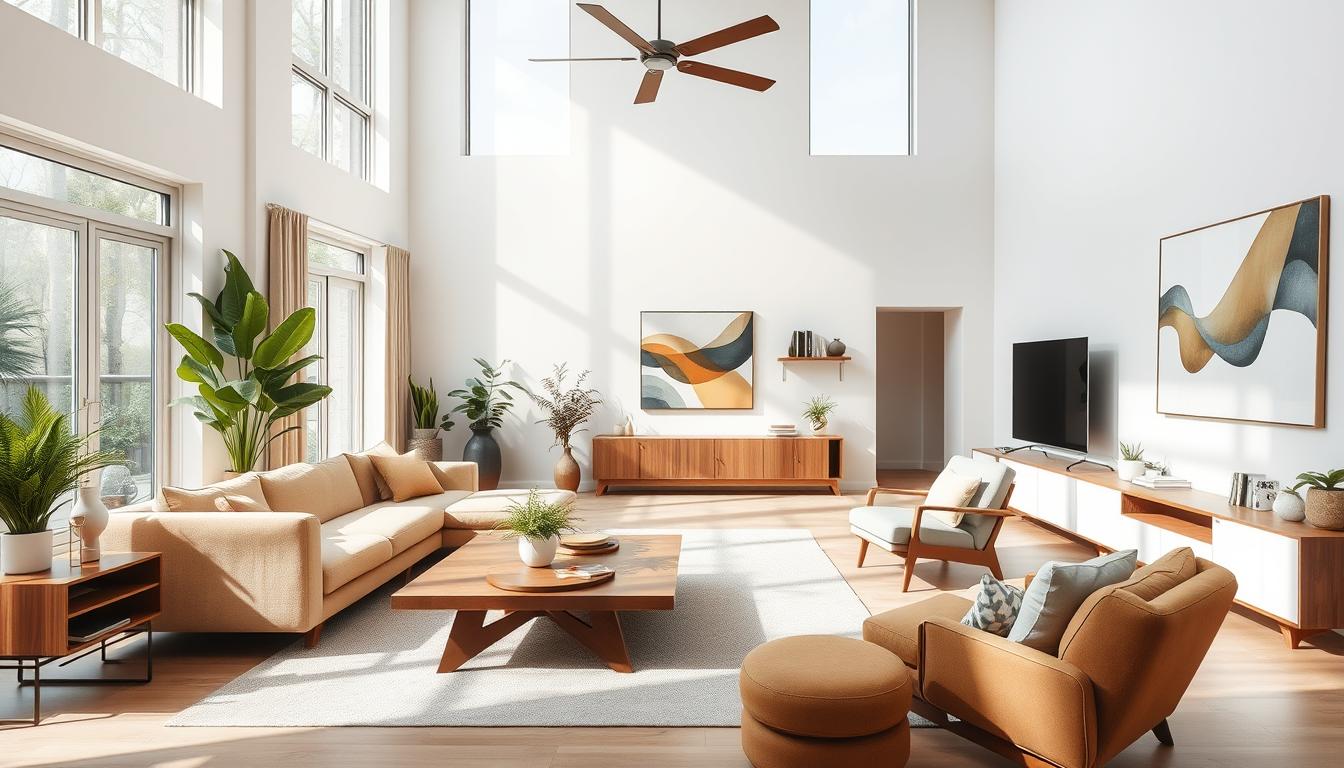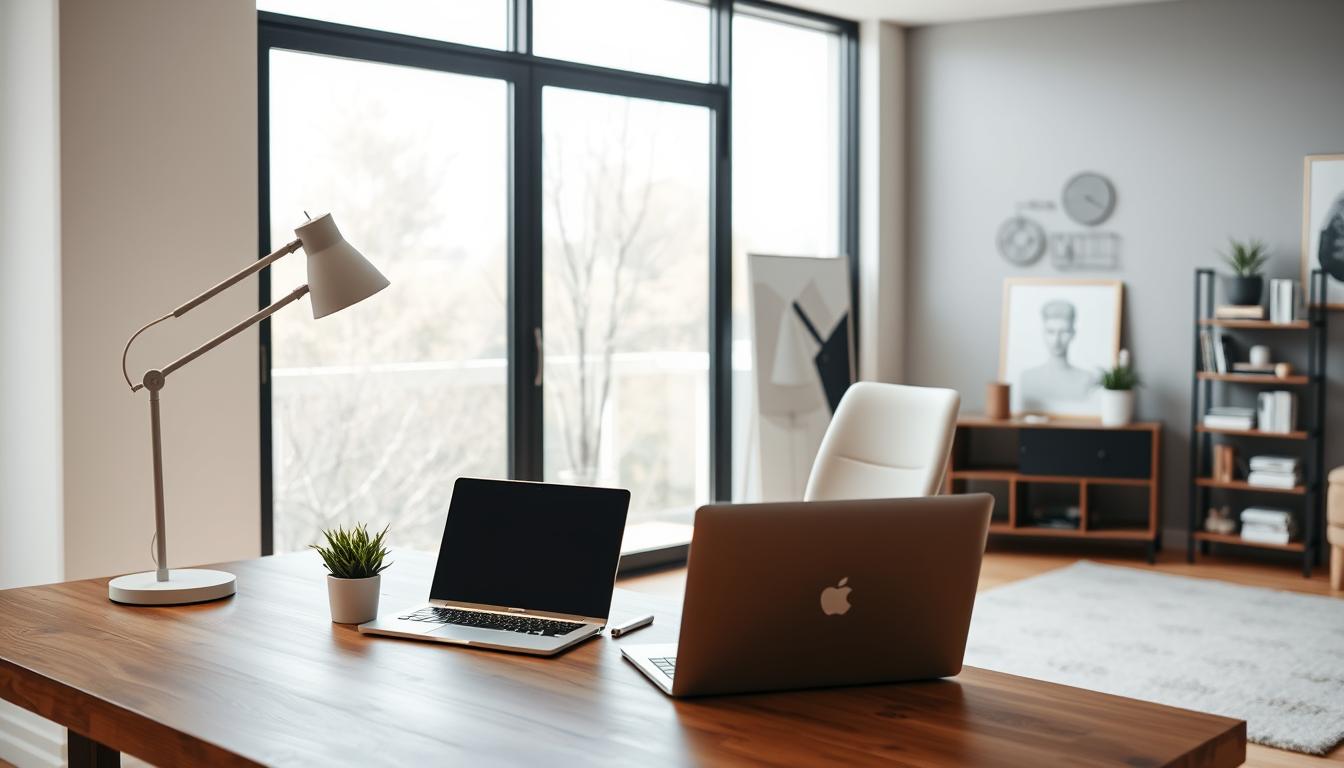Did you know a well-designed living space can really improve your mood and work? Making a stylish interior is more than looks. It’s about creating a space that works well and feels cozy, showing off your personal style. At Architectural Digest, they talk about many styles, like Scandinavian and Traditional, each with its own special features.
We’ve picked our top 10 home interior design ideas to help you make a space that’s both stylish and inviting. Whether you’re looking for stylish home renovation ideas or want to keep up with the latest interior design trends for homes, our guide is here to spark your creativity.
Key Takeaways
- Understand the importance of balancing aesthetics with functionality.
- Explore various interior design styles to find what suits your taste.
- Learn how to incorporate natural materials and textures into your space.
- Discover the impact of color schemes on the ambiance of your home.
- Find out how to make your space both stylish and cozy.
1. Embrace Minimalism for Clutter-Free Living
Minimalist design is changing how we live, making our spaces feel bigger and more welcoming. By going for minimalism, we can make our homes clutter-free. This not only looks good but also helps us live more sustainably.
1.1 Benefits of Minimalist Design
Minimalist design brings calm and clarity. It helps us focus better and be more productive. Plus, it makes our rooms look bigger and more beautiful.
One big plus of minimalist design is it’s good for the planet. It uses fewer resources and cuts down on waste. This helps the environment and encourages us to use resources wisely.
1.2 Key Elements of Minimalism
Minimalist design is all about simplicity, clean lines, and fewer colors. These elements make a space look neat and organized. Neutral colors like white, beige, and gray are favorites because they create a calm atmosphere.
- Simple and clean lines
- Limited color palette
- Minimal decor
- Ample negative space
1.3 Tips for Decluttering Your Space
Decluttering is key to embracing minimalism. Begin by going through your stuff and picking out what you don’t need or use. Think about donating or recycling these items to help others and reduce waste.
To keep your space tidy, make tidying up a regular habit. This keeps your space organized and peaceful.
- Sort through your belongings regularly
- Donate or recycle unused items
- Establish a tidying routine
2. Incorporate Sustainable Materials in Design
Creating a stylish space means using sustainable materials. This step helps make our home eco-friendly. Bringing the outdoors in adds warmth and character. Choosing green materials reduces our ecological footprint and makes our home healthier.
Why Sustainable Materials Matter
Sustainable materials are good for the environment. Choosing sustainable materials cuts down on deforestation and greenhouse gas emissions. They also improve indoor air quality, making our homes healthier.
- Reduce environmental impact
- Promote healthier indoor air quality
- Support eco-friendly manufacturing processes
Popular Eco-Friendly Materials
Popular eco-friendly materials include reclaimed wood, bamboo, and low-VOC paints. Reclaimed wood brings a unique history to a room. Bamboo is renewable and needs little water. Low-VOC paints clean the air, making them a smart choice for design.
Budget-Friendly Sustainable Options
Using sustainable materials doesn’t have to cost a lot. Options like recycled materials, sales, and repurposed furniture are affordable. DIY projects can also save money and add sustainable touches to our homes.
- Use recycled or repurposed materials
- Shop for second-hand furniture
- Opt for locally sourced materials to reduce transportation costs
By choosing sustainable materials, we can make our homes beautiful and eco-friendly. This shows our values and commitment to the planet.
3. Experiment with Bold Color Palettes
Starting a stylish space often begins with bold colors. A good color scheme makes a room inviting and changes its feel. The right colors can make a space lively and welcoming.
3.1 Choosing Your Color Scheme
Choosing the right color scheme is key. Think about the mood you want in your space. Cool colors like blues and greens calm a room. Warm colors like oranges and reds energize it.
To pick a color scheme, start with a main color. Then, choose colors that go well with it. Testing colors under different lights helps ensure they look good all day.
3.2 Accentuating with Accessories
After picking bold colors, add them with accessories. Use throw pillows, rugs, and wall art. These add interest and tie the room together.
To keep things balanced, mix bold colors with neutrals. For example, a bold red wall can be balanced with beige or gray furniture. This stops the space from feeling too much.
3.3 The Psychology of Colors in Design
Knowing how colors affect us helps in choosing them. Colors can make us feel certain ways. Yellow makes us happy, while blue calms us.
By thinking about color psychology, we can make a space that looks and feels great. The right colors can energize or relax a room, making it more welcoming.
4. Mix and Match Textures for Depth
Mixing textures makes your home cozy and inviting. It adds depth and interest. This makes your space feel layered and complex.
4.1 Understanding Texture in Interior Design
Texture is how something looks or feels. In design, it’s visual or tactile. Knowing about texture makes your space more engaging.
Visual texture is seen and can be changed with patterns and colors. Tactile texture is felt and invites touch.
4.2 Best Textures to Combine
Combining textures adds depth and interest. Good pairs include:
- Smooth surfaces like glass or metal with rough ones like wood or stone.
- Mixing matte and glossy finishes for contrast.
- Adding natural fibers like wool or linen with synthetic ones.
Trying different textures can make your space unique and personal.
4.3 Creating a Balanced Look
Mixing textures needs balance to avoid clutter. To balance:
- Start with a main texture and add contrasts.
- Use a common color to tie textures together.
- Spread textures evenly for harmony.
By carefully mixing textures, you can make a stylish, inviting home that shows your style.
5. Utilize Open Space Concept
Embracing the open space concept can change your home’s look. Open floor plans make a space feel bigger and more connected. This promotes a sense of community and flow.
Advantages of Open Floor Plans
Open floor plans are great for modern living. They help family members and guests interact better. Design experts say, “Open spaces foster a sense of togetherness and make it easier to keep an eye on children or engage with others while cooking or working.”
“The open floor plan has become a staple of modern home design, reflecting a shift towards more communal living spaces.” –
Open floor plans bring many benefits. They let in more natural light, improve airflow, and make space more flexible. Without walls, even small homes can feel bigger.
Tips for Defining Zones
While open floor plans are great, it’s key to define different zones for function. Here are some tips:
- Use area rugs to mark off different areas, like a living room or dining space.
- Place furniture to create separate zones; for example, a sofa can define a living area.
- Different lighting can also help define zones.
Furnishing for an Open Space
Choosing the right furniture is crucial for an open space. Multi-functional furniture is very useful here. It keeps the space open while providing needed functionality.
For example, a storage ottoman can be a seat and a storage unit. This reduces clutter and keeps the space neat. A console table behind a sofa can also act as a divider.
By picking the right furniture and decor, you can create a space that’s both harmonious and functional. It will meet your needs and improve your home’s look.
6. Add Statement Lighting Fixtures
Statement lighting fixtures are more than just lights. They add beauty to any room. The right lighting can make a space feel cozy and stylish.

Importance of Lighting in Design
Lighting is key in interior design. It lights up the room and highlights special features. Effective lighting design can make a room feel bigger, cozier, or more lively.
Lighting is crucial for setting the mood of a room. The right lights can make your space look better and feel welcoming.
Types of Statement Lighting
There are many statement lighting fixtures to choose from. They add elegance and sophistication to your home. Some popular ones include:
- Chandeliers: Perfect for making a bold statement in dining rooms or entryways.
- Pendant Lights: Ideal for task lighting in kitchens or adding a decorative touch above a dining table.
- Sconces: Great for adding ambient lighting and creating a cozy atmosphere in bedrooms or living rooms.
Each lighting fixture has its own look and purpose. Knowing your options helps you pick the perfect light for your space.
How to Choose the Right Fixture
Choosing the right lighting fixture involves several factors. Consider the room’s purpose, size, and decor. Here are some tips:
- Think about the room’s purpose: Different rooms need different types of lighting. Kitchens need task lighting, while living rooms need ambient lighting.
- Look at the room’s size: The size of the room and the ceiling height affect the type and size of the light you choose.
- Match the fixture to your decor: The light should fit with the room’s style. A modern chandelier works well in a contemporary home, while a traditional pendant light suits a classic interior.
By considering these factors, you can find a statement lighting fixture that lights up your space and makes it look great.
7. Personalize with Art and Décor
Adding art and decor to your space can really enhance its feel. It makes your home feel more like you. Art and decor show off your style and personality.
7.1 Selecting Artwork for Your Space
Choosing the right artwork is key. Pick pieces that speak to you or match your decor. Think about colors, themes, or how they make you feel.
Also, make sure the art fits well with your walls and furniture. You can go for a single theme or mix styles for a unique look.
7.2 Fun Ways to Display Décor
Displaying decor is an art in itself. Use shelves, mantles, or coffee tables to show off your favorites. Group similar items or mix textures and heights for interest.
Try using old items as displays, like vintage baskets. It adds a personal touch and tells a story.
7.3 Building a Gallery Wall
Building a gallery wall shows off your style. Pick a common theme, like frame style or color, to tie everything together.
Plan the layout on the floor before hanging. You can go for symmetry or an eclectic look. This makes your space truly yours.
With these creative interior design tips, your space will reflect your personality. It will be warm and welcoming for everyone.
8. Incorporate Natural Elements Indoors
Adding natural elements to our homes makes them more beautiful and healthy. This idea, called biophilic design, links nature with our living spaces.

Benefits of Biophilic Design
Biophilic design helps us feel less stressed, happier, and more productive. It uses plants, wood, and stone to make our homes feel welcoming and calm.
- Improved Air Quality: Plants clean the air, making it healthier to breathe.
- Enhanced Aesthetic: Natural elements add beauty and interest to our spaces.
- Boosted Well-being: Being near nature is good for our mental health.
Best Plants for Home Interiors
There are many stylish, easy-to-care-for plants for our homes. Some top picks include:
- Snake Plant: It cleans the air and grows well in little light.
- Spider Plant: Simple to care for and perfect for hanging.
- Peace Lily: Beautiful and good at cleaning the air.
Natural Light and Its Effects
Natural light is key to a healthy, welcoming home. It cuts down on the need for artificial lights and helps our bodies stay in sync with nature.
To get more natural light, use sheer curtains, mirrors, and light colors. These help reflect and spread light in your home.
| Benefits of Natural Light | Tips for Maximizing Natural Light |
|---|---|
| Regulates Circadian Rhythms | Use sheer curtains to filter light |
| Improves Mood | Place mirrors opposite windows |
| Reduces Need for Artificial Lighting | Paint walls with light-colored paints |
9. Design Functional Spaces with Purpose
Creating a functional space means making it look good and work well. We do this by knowing what the space needs and adding things that make it easier to use.
9.1 Identifying Your Space’s Purpose
First, figure out what the space is for. Is it for chilling out, working, or having fun? Knowing this helps us choose the right layout, furniture, and decor.
For example, a home office needs good storage and a comfy spot to work. A living room should focus on places to sit and have fun.
9.2 Multi-Functional Furniture Ideas
Using furniture that does more than one thing is smart. Items like storage ottomans, sofa beds, and coffee tables with storage help keep things tidy and make the space more useful.
Here are some cool multi-functional furniture ideas:
- Storage beds with drawers underneath
- Nesting tables that can be easily stored
- Wall-mounted desks that save floor space
9.3 Layout Planning for Efficiency
Good layout is essential for a functional space. It means arranging furniture so it’s easy to move around. Think about the “work triangle” in kitchens, where the sink, stove, and fridge form a triangle for better movement.
Here’s a simple layout plan for a living room:
| Furniture | Placement Consideration | Benefits |
|---|---|---|
| Sofa | Against a wall, facing the TV | Creates a cozy seating area |
| Coffee Table | In front of the sofa | Provides a surface for drinks and snacks |
| TV Stand | Under or near the TV | Organizes media devices and accessories |
By planning the layout well and picking the right furniture, we can make spaces that are both pretty and practical.
10. Play with Scaled Furniture Choices
Creating a stylish living area means thinking about furniture size. The size of your furniture greatly changes how a room feels. Choosing furniture that fits the room well makes the space balanced and nice.
Importance of Scale in Design
Furniture size is very important in design. Furniture that’s too big can make a room feel cramped, while too small can make it look empty. The right size furniture makes a room look good and work well. It also makes sure you can move around easily.
Proportions and Visual Balance
Getting a room to look balanced is all about size. It’s about matching furniture, decor, and space. Think about how each piece fits with the room and each other.
| Furniture Piece | Room Size Consideration | Visual Impact |
|---|---|---|
| Sofa | Should be proportional to the room’s dimensions | Dominant piece, sets the tone for the room |
| Coffee Table | Should be in scale with the sofa | Creates a sense of harmony and flow |
| Accent Chairs | Should complement the scale of the sofa and coffee table | Adds depth and visual interest |
Sourcing Scaled Furniture Pieces
Finding the right furniture size can be hard. Measuring your room and furniture is key. Use online tools or get help from an interior designer. Always ask for measurements when shopping.
By focusing on furniture size, you can make a living space that’s both stylish and practical. It will feel welcoming and balanced.
11. Stay Updated with Trends and Innovations
To keep your space looking fresh, it’s key to know the latest interior design trends. We can find inspiration from design blogs, social media, and home decor magazines. Some top resources include Houzz, Architectural Digest, and Design Milk.
Current Trends
Following interior design trends can make updating your space exciting. We can add modern touches like sustainable materials and bold colors. For fresh ideas, check out IKEA and West Elm.
Balancing Trends with Timelessness
It’s important to mix trendy pieces with classic furniture and decor. This way, our space stays stylish and timeless. By blending the two, we create a space that reflects our personal style.


